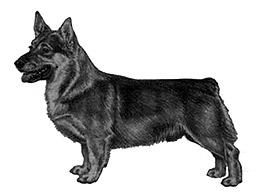Breed standards
Swedish Vallhund
Breed standards are the official guidelines that describe the ideal characteristics, temperament, and appearance of a breed and ensures that the breed is fit for function with soundness essential.

Kennel Club, London 1994
Small, powerful, sturdily built working dog, with fairly long body. (Ratio of height at withers to length of body 2:3)
Appearance and expression denote a watchful, alert, energetic dog.
Friendly, active, eager to please.
Rather long and a clean cut, blunt wedge with almost flat skull and well defined stop. Viewed from above, shows an even wedge shape from skull to tip of nose. Muzzle, viewed from side, looks rather square, slightly shorter than skull. Lower jaw strong. Although a dark mask is acceptable, a well defined mask is highly desirable with lighter hair around eyes, on muzzle and under the throat, giving a distinct contrast to the upper mask. Tightly closed lips. Nose black.
Medium size, oval, very dark brown.
Medium size, pointed, pricked, leather hard from base to tip, but fine smooth haired and mobile.
Scissor bite-Jaws strong with a perfect, regular and complete scissor bite, i.e. upper teeth closely overlapping lower teeth and set square to the jaws.
Long, strongly muscled with good reach.
Shoulder blades long and well laid. Upper arm slightly shorter than shoulder blade and set at a distinct angle. Upper arm lies close to ribs, but is still very mobile. Forearm, when viewed from front, slightly bent, just enough to give free action to chest's lower part; straight when viewed from side. Legs well boned.
Back level, well muscled, with short, strong loin. Chest long with good depth. Well sprung ribs. Viewed from front, chest oval, from side elliptical. Reaching two-fifths of length of forearm. When viewed from side the lowest point of chest is immediately behind back part of foreleg. Sternum visible but not excessively pointed. Croup broad and slightly sloping. Belly slightly tucked up. Harness markings should be clearly defined.
Well angulated, well bent stifles and low hocks, thighs strongly muscled. Legs well boned.
Medium, short, oval, pointing straight forward with strong pads. Well knuckled up.
Docked: Length not exceeding 10cms (4 ins) when adult. Set on as a continuation of croup line. May be raised at attention.
Undocked: May be born tailless. Any length. Natural carriage.
Free and active, elbows fitting closely to sides, forelegs moving well forward without too much lift, in unison with powerful thrusting hind action.
Medium length, harsh, close and tight topcoat, undercoat abundant, soft, woolly.
Steel grey, greyish/brown, greyish/yellow, reddish/yellow, reddish/brown with darker guard hairs on back, neck and sides of body, lighter hair same shade of colour as mentioned above is desirable on muzzle, throat, chest, belly, buttocks, feet and hocks. Instead of these lighter shades, white markings are acceptable, but never in excess of one-third of total colour. Any colour other than the above, including white and blue or any non-standard colour, is highly undesirable.
Height:
Dogs 33-35 cms (13-13.75 ins) at withers
Bitches 31-33 cms (12-13 ins) at withers
The relation between height at withers and length of body should be 2:3.
Weight: 11.5-16 kgs (25-35 lbs)
Any departure from the foregoing points should be considered a fault and the seriousness with which the fault should be regarded should be in exact proportion to its degree and its effect upon the health and welfare of the dog.
Male animals should have two apparently normal testicles fully descended into the scrotum.



